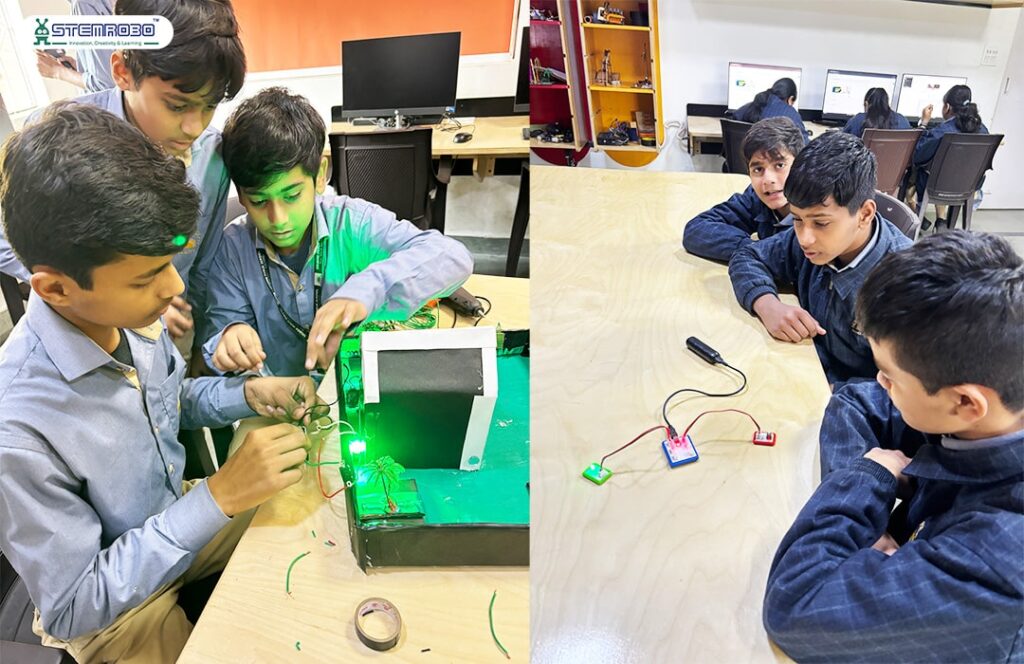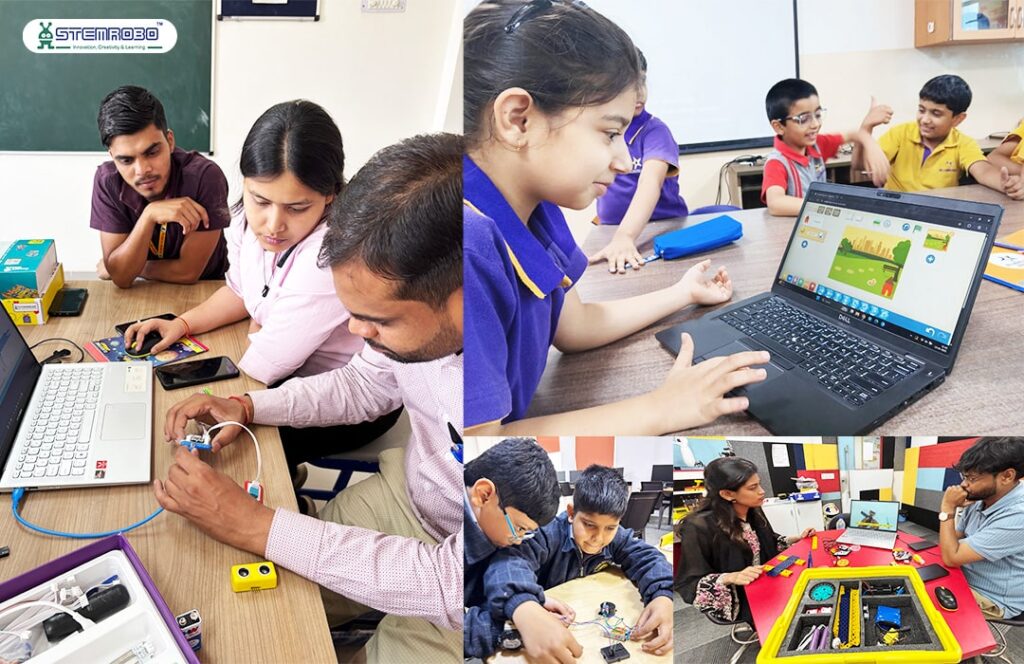The present scenario of digitalisation is very rapidly making strides and the need of the hour is to make ourselves tech savvy to keep up with the modernisation. Just like there are driving rules, there are also rules to keep us safe and sound in this digital ecosystem.
Nowadays children are getting access to the digital world very early on. They now have online classes, coding classes etc and to ensure that your kids are safe and sound, digital literacy should be an important component in their curriculum.
It’s like giving kids the rulebook and the wisdom to be great digital citizens. It’s also where amazing initiatives like STEM education (Science, Technology, Engineering, Math) and the Government initiatives like Atal Tinkering Labs (ATLs) are making a huge difference.
Organizations like STEMROBO ensure that students not only learning technology but also learning how to use it the right way. We’re not just bringing futuristic gadgets and coding kits into schools; we’re also teaching kids the “how-to” of navigating this vast online world without falling into traps or losing their online safety.

So, let us understand what “Digital Literacy” truly means; why it’s a superpower every student needs today. It includes the ability to:
1.) Access and evaluate digital content critically
2.) Communicate and collaborate online respectfully
3.) Use software and apps to solve problems or create new content
4.) Stay safe by protecting one’s privacy, data, and digital reputation
It’s a combination of technical skills, critical thinking, and ethical responsibility. Just as traditional literacy enables us to read, write, and comprehend, digital literacy enables us to understand, create, and interact safely in an online world.
Why Is Digital Literacy Important?
Every time a student logs into a website, posts on social media, downloads an app, or even plays an online game, they leave behind a trail of data, known as the digital footprint. And this can expose a lot about the person, their likes, dislikes, locations, passwords etc.
Without digital literacy, students may unknowingly:
1.) Share sensitive personal information
2.) Fall victim to cyberbullying or online scams
3.) Be exposed to misinformation or fake news
4.) Damage their online reputation, possibly affecting future education or job prospects
With cyber threats and data breaches on the rise, teaching students how to protect their digital footprint is no longer optional, it’s essential.
STEM Education: Creating Smart, Safe Digital Citizens
STEM stands for Science, Technology, Engineering, and Mathematics. It’s not just a subject, it’s a teaching approach that encourages curiosity, creativity, and problem-solving. It makes students ready for the future that is intricately embedded with technology.
STEM education today includes digital awareness. It teaches students how to code, how to use tech tools, how to think logically, and how to stay secure while doing all of that.
Through STEM, children are encouraged to be:
1.) Thinkers: Able to question digital content and avoid fake news
2.) Creators: Capable of designing apps, building robots, and innovating with tech
3.) Responsible Users: Who understand online etiquette, privacy, and security
This special way of thinking doesn’t just get students ready for the jobs that haven’t even been invented yet but it also helps them to be smart, responsible citizens right now in our increasingly digital world. It makes them more curious, question the reliability of things and situations
Atal Tinkering Labs : Where Young Minds Become Super Inventors!
Think of Atal Tinkering Labs (ATLs) as clubhouses for budding scientists and engineers, popping up in schools all over India! These amazing spaces are an initiative by the Indian government, like a special mission to spark creativity.
These labs are packed with cool, modern tech toys and tools, including:
- Robotics kits
- IoT sensors
- DIY electronics tools
- 3D printers
- Coding platforms etc.
The goal? To foster a culture of innovation, experimentation, and entrepreneurship among school students from a young age.
ATL labs don’t just teach science but they make it fun and real. Students get to:
1.) Build their own robots
2.) Solve local community problems through tech
3.) Learn how AI works through hands-on projects
4.) Explore ethical use of technology and digital safety
What’s more, ATL curriculum often includes modules on cybersecurity, data privacy, digital communication, and responsible use of the internet, all key parts of digital literacy.

How STEMROBO is making it happen-
It makes customised plans as to help the schools get the best outcome. It helps set up and manage ATL labs, and also offers:
1.) Structured programs on coding, robotics, AI, and digital safety
2.) Training for school teachers to become STEM mentors
3.) Interactive sessions on how to stay safe online
What makes us stand out is its student-first approach. The aim is not just to teach students to build machines or write code, but also to:
-Think independently, use tech ethically, communicate safely online and understand how their data is being used.
By integrating digital literacy into STEM learning, STEMROBO ensures that innovation never comes at the cost of safety.
Impact on Students: Confidence, Creativity, and Caution
Thanks to STEM education and ATL labs powered by STEMROBO, students across India are showing:
- More confidence in using digital tools
- Greater awareness of how to protect their privacy
- Better problem-solving and design-thinking skills
- Higher participation in coding, innovation, and national tech competitions
And most importantly, they’re learning how to use technology to improve their lives without risking their digital well-being.
Conclusion: Building a Safer Digital Future
As the digital landscape continues to grow rapidly, the need to be digitally literate becomes important because now all our personal information is online. And becomes an easy access for hackers and fraudsters to pry and steal information.
At STEMROBO, we combine STEM education with hands on learning. We are teaching the students not just technology but also how to succeed in life
They’re not just learning how to build robots or apps, they’re learning how to build a safer, smarter future.
And it all starts with that first step: understanding the value of digital literacy.

